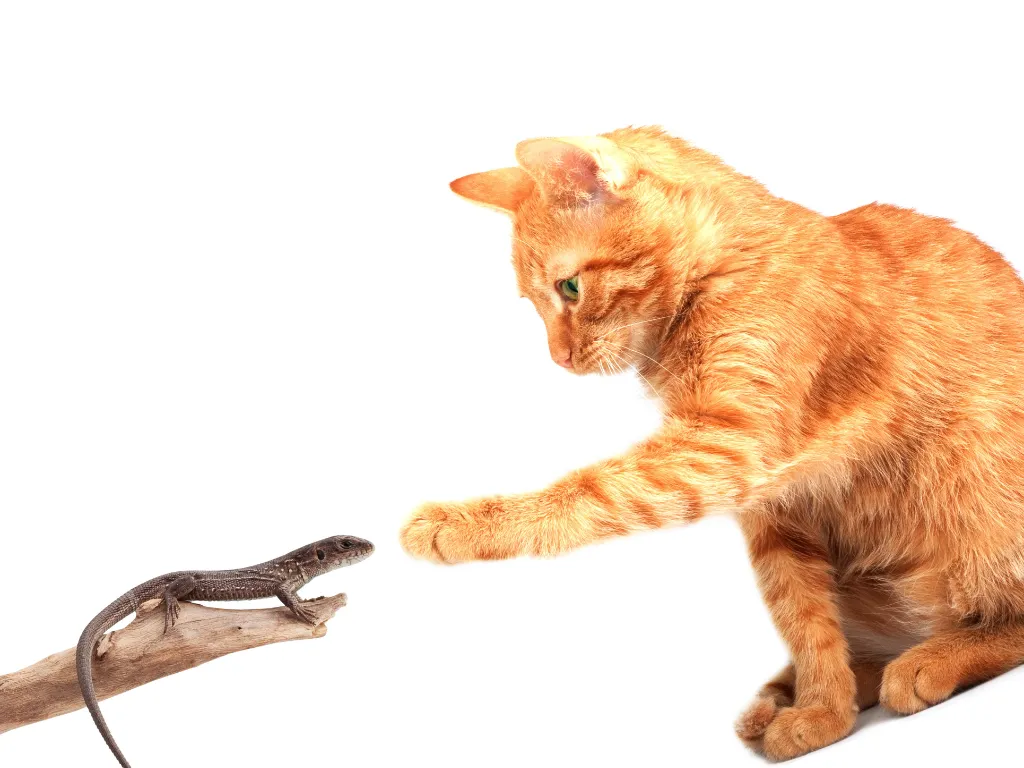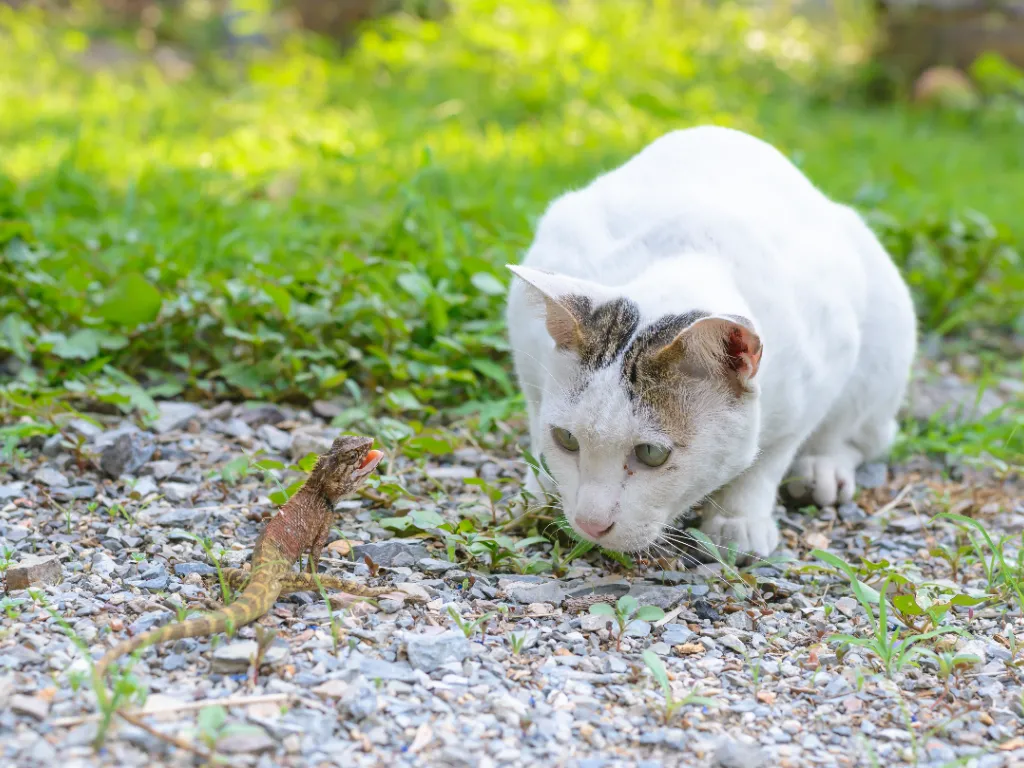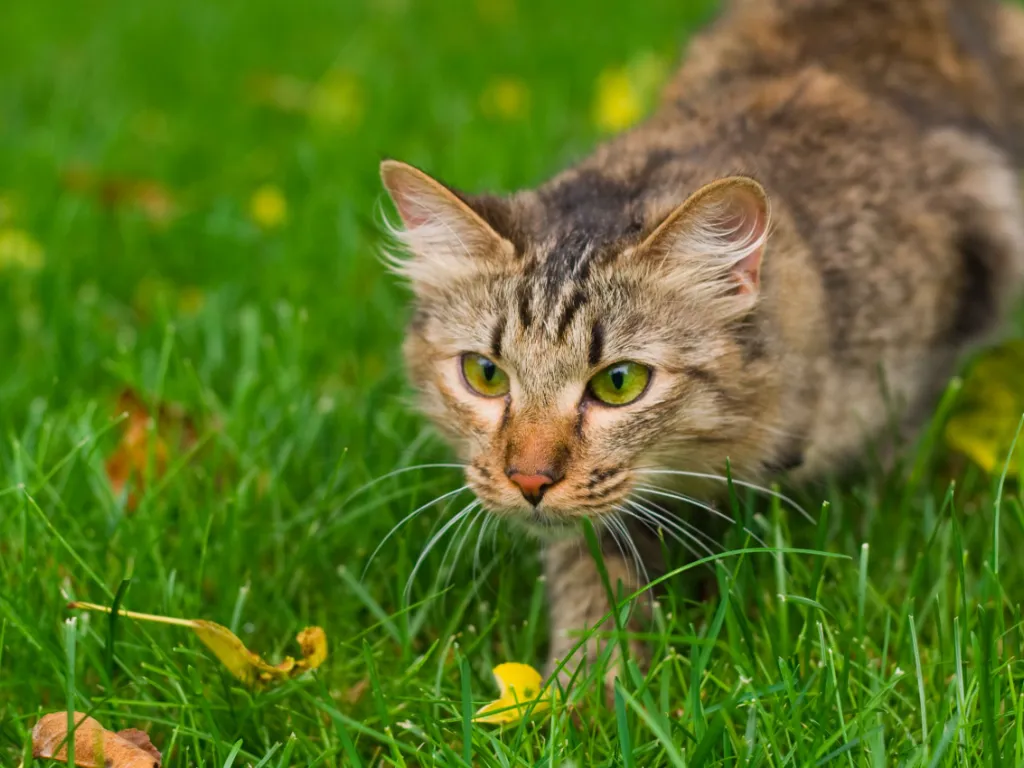As cat owners, we often admire our pets’ hunting instincts and playful nature. However, these seemingly harmless behaviors can sometimes expose our pets to unexpected risks and endanger their health.
One such risk occurs when cats interact with intriguing small creatures like blue-tailed skinks. Many cat owners wonder are blue tailed lizards poisonous to cats and if they should be worried if their cat catches one.
Skinks are the most common blue-tailed lizard that your cat is likely to encounter. While blue-tailed skinks do not have poisonous bites and are not poisonous if eaten, they do come with some risks if cats were to catch and eat them.
This article aims to clarify common misconceptions about blue-tailed skinks and explain how they can indirectly harm cats. It also provides useful tips for cat owners on preventing their pets from hunting and eating these reptiles.
What Are Blue Tailed Lizards?
Probably the most common blue-tailed lizard is the blue-tailed skink. Their small size makes them very popular with reptile enthusiasts as they make great pets even for beginners and they are abundant in the wild in many regions.
However, they aren’t the only lizards with blue tails. Let’s have a look at the different species that can fall into this category.
Blue Tailed Skinks
The “blue-tailed skink” category can include several different species of skinks, including the coal, mountain, mole, prairie, western, four-lined, great plains, African five-lined, and the common five-lined skink.
These small lizards all have a bright blue tail as juveniles, but most lose their blue color as adults. In some cases, the tail remains blue but dulls and darkens in color as the lizard ages so that it is no longer the recognizable bright blue.
Monitors
There are several species of monitors that have blue tails. Or, more specifically, they have bands of blue rings on their tails. These include the blue tree monitor and blue-tailed monitor, among others.
Whiptails
There are also several species of whiptails that can have blue tails. Some, like the desert grassland whiptail, have blue tails as juveniles that change color as they get older. Others, like the little striped whiptail, can have color morphs with or without blue tails.
Other Blue Tailed Lizards
Other types of lizards that can have blue color on their tails include the desert spiny lizard and the ashy gecko. The desert spiny lizard’s bright blue color is often on its belly, back, or chest, with some muted blue on the tail. The ashy gecko can have a bright blue tail, but their tails can also be red instead.

Are Blue Tailed Lizards Poisonous to Cats?
There are thousands of known species of lizards and yet only a few of them are known to be venomous. The most notable venomous lizards are the gila monster and the komodo dragon. But of the blue-tailed lizards listed above, only monitor lizards are known to be venomous.
Monitor lizards are not venomous in the same way that some snakes or spiders are, but they do possess a unique feature related to venom. Some species of monitor lizards have specialized glands in their lower jaws that produce and store toxic saliva.
While not truly venomous, when a monitor lizard bites its prey, this toxic saliva can be introduced into the wound, potentially causing infection or discomfort. It also prevents blood from clotting, causing their prey to slowly die from blood loss.
However, not all monitor lizard species possess this feature, and although their bites can be painful they are generally not considered highly dangerous to humans. They can, however, kill a small animal such as a cat. When it comes to monitor lizards, it’s always wise to exercise caution.
Are Blue Tailed Skinks Poisonous If Cats Eat Them?
When people think about blue-tailed lizards, most often they are thinking of blue-tailed skinks. There is no scientific evidence that skink bites are poisonous, nor are they poisonous if eaten. But what about the other blue-tailed lizards?
Again, with these other lizards, there is no evidence that they are poisonous if eaten. If a cat were to eat a small monitor lizard, there may be risks of internal bleeding if they also consume the head where the venom sacs are.
The other blue-tailed lizards such as the whiptail, desert spiny lizard, and ashy gecko are not considered to be poisonous lizards. In general, blue-tailed lizards are not a poisonous threat to cats if eaten or otherwise encountered.
Why Do People Think That Blue Tailed Skinks Are Poisonous When They Are Not?
Despite lack of evidence to the contrary, there is a common misconception that blue-tailed skinks are poisonous. This idea may be perpetuated among pet owners for several different reasons:
- Coloration: Many venomous or toxic animals have bright colors to signal their potential danger to predators. The vivid blue tails of these lizards could lead some pet owners to assume they are poisonous.
- Lack of knowledge: Pet owners may not be familiar with the specific species of blue-tailed skinks in their area and may wrongly assume that any unfamiliar lizard is dangerous.
- Defensive behavior: When cornered or threatened, blue-tailed skinks may hiss, puff up, or even bite. These behaviors, although not indicative of toxicity, can be misinterpreted as signs of a poisonous animal.
- Generalized fear of reptiles: Some people have a fear or phobia of reptiles, which can lead to an overgeneralization that all reptiles, including harmless lizards like blue-tailed skinks, are dangerous or poisonous.
- Rumors: There seem to be rumors circulating online that some cats have developed symptoms of vestibular disease (dizziness, head tilt, circling, abnormal eye movements) after eating skinks. However, there is no proof that this has happened, and there is no known reason why eating a skink would have this effect on cats.
While the idea that these lizards are poisonous to cats has no merit, there are other reasons why its a bad idea to let your pet eat these animals.

Why Blue Tailed Skinks Are Dangerous To Cats
Eating skinks can, however, result in serious health problems for cats. For example, wild blue-tailed skinks can carry a number of different parasites. Among these are liver flukes.
When the cat ingests skink with liver flukes, it also ingests the liver fluke larvae contained within the skink’s tissues. These larvae can migrate from the cat’s digestive system and travel to the liver, where they mature into adult flukes.
Once in the cat’s liver, the parasitic liver fluke infection can cause various health problems. They may damage the liver tissue and block bile ducts, leading to inflammation, fibrosis, and potential complications. Infected cats can exhibit symptoms such as loss of appetite, vomiting, diarrhea, weight loss, and abdominal pain.
Skinks may also harbor other internal parasites, such as nematodes or tapeworms. If a cat eats an infected skink, it can become a host for these parasites, leading to various health issues.
In addition, blue-tailed skinks, like many reptiles, may carry harmful pathogens like salmonella bacteria on their skin or in their digestive tracts. When a cat consumes a skink, it can ingest these bacteria, potentially leading to gastrointestinal infections or illnesses. Even pet skinks are known to carry these bacteria.
If your cat starts to show any of the symptoms discussed above such as vomiting, diarrhea, weight loss, or abdominal pain, they need medical attention and should be taken to see a veterinarian as soon as possible.
These symptoms could be an indication of an internal parasite infestation, liver fluke disease, or bacterial infections like salmonella which can all be a result of consuming a blue-tailed skink. Delaying treatment may lead to severe health complications.
How To Keep Your Cat From Hunting And Eating Blue-Tailed Skinks
There is no denying it, cats cannot resist chasing a skink! Cats are instinctively attracted to skinks due to their quick movements and vibrant blue tails. Skinks activate a cat’s predatory response, triggering their desire to stalk, pounce, and catch.
This interaction provides mental and physical stimulation for cats and satisfies their curiosity and sense of challenge. Skinks become irresistible targets for playful or hunting cats due to their elusive nature and ability to dart in and out of sight.
The best way, and only sure way, to keep your cat from hunting skinks is to keep them indoors or keep them on a leash if you take them outdoors. You can also consider building a “catio”, an outdoor enclosure for cats that will keep them separated from wildlife while still letting them enjoy being outside.
If your cat is an indoor/outdoor cat, you can also take measures to make your yard or garden less attractive to skinks. Keep vegetation trimmed away from the house and mow the lawn regularly.
Skinks are shy creatures that look for dark, moist places like tall grasses, logs, or rock piles to hide in during the day. Eliminating these hiding spots may help keep them away from your yard.
If you do see a skink in your yard, pick it up if you can and release it somewhere safe away from predators, such as behind a bush or under some rocks.
If your cat roams free outside without supervision, there is little that you can do to stop it from hunting skinks or any other small animal. Domestic cats that roam free are responsible for killing billions of small animals every year, and are a serious threat to bird and small mammal populations everywhere.

Conclusion
As cat owners, it’s our responsibility to ensure our pets’ well-being and educate ourselves about potential dangers.
While blue-tailed skinks are not poisonous, they can indirectly cause health issues in cats due to potential parasites and harmful bacteria. Although chasing skinks might be exciting for our feline friends, the health risks from ingesting these reptiles outweigh the momentary distraction.
By taking preventive measures, like keeping a skink-free outdoor environment and finding safe alternatives for outdoor play, we can help keep our cats healthy and safe.
Want to know more about what cats can and can’t eat? Check out our article on foods cats should stay away from here!
Sources:
